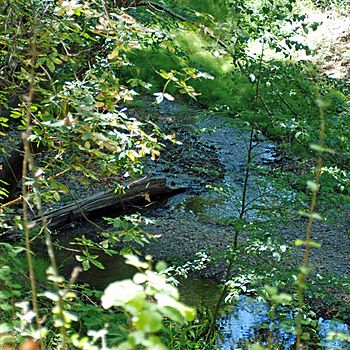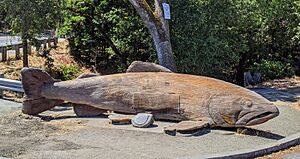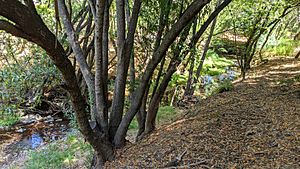Bear Creek (San Francisquito Creek tributary) facts for kids
Quick facts for kids Bear Creek |
|
|---|---|

Bear Creek coming down from top of photo to join with Corte Madera Creek at bottom of photo, forming San Francisquito Creek below Searsville Dam.
|
|
| Other name(s) | Arroyo de la Presa Bear Gulch Creek |
| Country | United States |
| State | California |
| Region | San Mateo County |
| City | Woodside, California |
| Physical characteristics | |
| Main source | Northeast slope of Sierra Morena, California a summit in the Sierra Morena portion of the Santa Cruz Mountains, near Kings Mountain, California Woodside 2,150 ft (660 m) 37°25′09″N 122°19′09″W / 37.41917°N 122.31917°W |
| River mouth | San Francisquito Creek Jasper Ridge Biological Preserve, Stanford University 256 ft (78 m) 37°24′36″N 122°14′18″W / 37.41000°N 122.23833°W |
| Basin features | |
| Tributaries |
|
Bear Creek, also known as Bear Gulch Creek, is a stream about 6.6-mile-long (10.6 km) in San Mateo County, California, United States. It starts in the Santa Cruz Mountains near Kings Mountain, California. The creek flows southeast through the town of Woodside. Bear Creek eventually joins with Corte Madera Creek to form San Francisquito Creek. This meeting point is inside the Jasper Ridge Biological Preserve at Stanford University.
Contents
History of Bear Creek's Name
The Spanish people first called this creek Arroyo de la Presa. This name means "creek of the dam." It was part of a large land area called Rancho Cañada de Raymundo.
In 1850, a man named James H. Ryder was working for a lumber company. He used strong oxen to pull logs to what is now Redwood City. One day, two of his oxen went missing. When Ryder stopped for a drink at the creek, he was attacked by a California grizzly bear and her two cubs. Ryder was badly hurt but survived. After this event, the creek became known as Bear Gulch Creek. James Ryder was even nicknamed "Grizzly" Ryder!
The Amazing Story of Indomitable Salmon

Outside Buck's of Woodside restaurant, there is a large wooden sculpture of a salmon. This sculpture was made to remember a salmon's incredible journey. On December 2, 1964, a worker at the Prairie Creek Fish Hatchery in Humboldt County, California found a two-year-old coho salmon. This salmon was swimming in a tank of baby fish, exactly where it had been raised two years before!
To get back to that tank, the salmon had to travel a very long and difficult path. It swam from the Pacific Ocean up Redwood Creek. Then, it turned into Lost Man Creek, went up a ditch, and through a 1.5 feet (0.46 m) pipe under Highway 101. It continued through a storm sewer and then up the hatchery's waste water pipe, which was only 4 inches (10 cm) wide. Inside this pipe, it made a sharp 90-degree turn and jumped 2.5 feet (0.76 m) vertically. Finally, it pushed through a wire screen to get into the rearing pond.
The local news quickly nicknamed this amazing fish Indomitable, meaning "unbeatable." Workers later found 72 more young salmon stuck in the pipes, trying to follow Indomitable. This story became very famous and is still talked about as one of the most amazing feats of animal migration. The original salmon sculpture is now located outside Buck's of Woodside, near a small stream that flows into Bear Gulch Creek.
Bear Creek's Water System

The main part of Bear Creek is formed when Bear Gulch Creek and West Union Creek join together. This happens near Kings Mountain Road and Highway 84 in Woodside. Many smaller creeks and gulches flow into Bear Creek. This pattern was created by the movement of the San Andreas Fault.
West Union Creek starts in the Phleger Estate, which is now part of a state wildlife area. Other streams that feed into Bear Creek flow through public lands like Huddart County Park and Teague Hill Regional Open Space Preserve. The entire area that drains water into Bear Creek, called its watershed, covers about 13 square miles (34 km2).
Some of the water from Bear Creek is collected at special dams. This water is stored in Bear Gulch Reservoir. It provides about 20% of the drinking water for Woodside, and up to 50% in winter. This water also helps supply people in Menlo Park, Atherton, and Portola Valley.
Wildlife in Bear Creek
Bear Creek and its smaller streams are important for a type of fish called steelhead (Oncorhynchus mykiss). These fish are like salmon. Adult steelhead swim from the San Francisco Bay into the freshwater streams of Bear, West Union, and Bear Gulch Creeks to lay their eggs. Steelhead are considered a threatened species, which means their numbers are low and they need protection.
Young steelhead fish spend their first two years in freshwater. This means they need streams that flow all year, or at least have deep pools of water to survive. The way West Union Creek flows, with its gentle slope, creates excellent places for steelhead to live. Many natural springs along the fault line also create permanent pools, which are very important for the survival of young steelhead.
In the past, there were many things blocking the path of trout in Bear Creek and its smaller streams. In 2001, experts found 34 barriers that made it hard for fish to migrate. One big problem was a pipe under Richards Road in Huddart County Park. This pipe made it difficult for both adult and young steelhead to move. Luckily, this pipe has been rebuilt to help the fish swim freely again.


